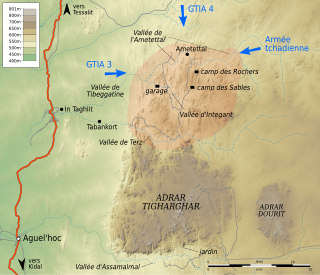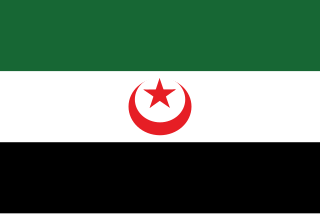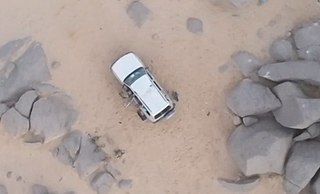The siege of Tessalit occurred in early 2012 during the Tuareg rebellion in Mali. Amachach military base, located in Tessalit, was defended by roughly 800 Malian soldiers commanded by Colonel Kassim Goita. The International Committee of the Red Cross was sent to help evacuate civilians and military families, but despite the approval of the National Movement for the Liberation of Azawad (MNLA), Malian authorities delayed the operation and it was never executed as a humanitarian source. Other Malian military forces in the region of Tessalit were led by Colonels' Didier Dacko, Ould Meydou, and the well respected Tuareg commander El Hadji Ag Gamou.

The Battle of Ifoghas, also known as the Battle of Tigharghâr or the Battle of the Ametettai, took place from 18 February to 31 March 2013, during the Northern Mali conflict. The French army and the Chadian army fought armed Salafist jihadist groups led by Al Qaeda in the Islamic Maghreb and Ansar Dine. After being defeated in January in the Battle of Konna and the Battle of Diabaly, the jihadists abandoned Timbuktu and retreated into the Adrar Tigharghar, a mountain of the Adrar of Ifoghas in northeastern Mali, which has been their sanctuary for years. The French started quickly a pursuit, and they took control of the towns of Tessalit and Aguelhok and begun the operation Panther in the Tigharghar. The first clashes erupt on February 18 and are mainly concentrated in the Ametettai Valley. It is caught between two armored columns, one French to the west and another Chadian to the east, while the paratroopers manage to surprise the jihadists by attacking on foot from the north. The valley is taken on March 3 and jihadists begin to gradually abandon the Tigharghar. Excavation missions and some skirmishes, however, continue to take place the following days. The operations cease on March 31. The battle was a turning point in the war, as with the capture of the Tigharghar, the jihadists lose their main sanctuary in the Sahel as well as most of their military arsenal, taken from the Malian army or Libya.

Operation Serval was a French military operation in Mali. The aim of the operation was to oust Islamic militants from the north of Mali, who had begun a push into the center of Mali.

The Battle of Konna was a battle in the Northern Mali Conflict in the town of Konna in central Mali. Various Islamic fundamentalist rebels fought with the government of Mali, the latter of which was supported by French soldiers participating in Operation Serval. This battle was among the first French engagements in their intervention in the Mali War.

The Battle of Diabaly was fought between government forces of Mali, against groups of Islamists militants such as the AQIM and Ansar Dine. The Islamists held control of Diabaly for no longer than a week until Malian forces with the help French air strikes recaptured the town.

The Second Battle of Gao was the recapture of the city of Gao from Islamist MOJWA fighters by Malian/French forces. It took place in January 2013 within the Northern Mali Conflict.

Operation Panther was a French military operation in Mali that was launched in February 2013.
The Battle of Imenas was an armed confrontation between French-Malian forces and the Jihadists terrorist groups, Movement for Oneness and Jihad in West Africa and Al-Mulathameen. The battle was a decisive Franco-Malian victory, as it resulted, according to the French and the Malian governments, in 52 Islamists being killed, with no government forces being killed.
The Battle of In Khalil took place on 22–23 February 2013 and was part of the first stage of the Mali War.
On March 6, French and Malian forces took control of the Wadi Tin Keraten area, located 100 km east of Gao and northeast of Imenas. When Malian soldiers got near Tin Keraten, they were attacked by Islamists from MOJWA. French ground troops arrived supported by Tiger helicopters and Gazelles along with some warplanes. Four Malian soldiers were wounded during the battle and a French soldier, sergeant Wilfried Pingaud of the 68th Artillery Regiment in Africa, was mortally wounded. He was transported to Gao, where he died of his wounds. The Islamists lost about ten men according to French reports.

The Arab Movement of Azawad is an Arab military organization active in Azawad/northern Mali. Initially known as the National Liberation Front of Azawad, it was formed in early 2012, during the 2012 Tuareg rebellion. The MAA claims to be a secular, non-terrorist organization, whose main objective is to defend the interests of all the Arab peoples of northern Mali.

Operation Barkhane was a counterinsurgency operation that started on 1 August 2014 and formally ended on 9 November 2022. It was led by the French military against Islamist groups in Africa's Sahel region and consisted of a roughly 3,000-strong French force, which was permanently headquartered in N'Djamena, the capital of Chad. The operation was led in co-operation with five countries, all of which are former French colonies that span the Sahel: Burkina Faso, Chad, Mali, Mauritania and Niger. Mali was a part of the operation until August 2022. The countries are collectively referred to as the "G5 Sahel". The operation was named after a crescent-shaped dune type that is common in the Sahara desert.

The Battle of Talahandak took place on 3 June 2020 during the Mali War. It resulted in the death of Abdelmalek Droukdel, the leader of al-Qaeda in the Islamic Maghreb (AQIM).

The Air Parachute Commando No. 10, is a French special forces unit of the French Air and Space Force and is attached to the Special Operations Command. It is currently headquartered in Air Base 123. The unit specialises in Counterterrorism, Unorthodox warfare, Special Reconnaissance, Combat Search and Rescue and Aerial guidance (JTACs).
Mohamed Lemine Ould El Hassen, nom de guerre Abdallah al-Chinguetti, was a Mauritanian jihadist and commander of Katiba Al Furqan of the Al-Qaeda in the Islamic Maghreb.
Hamada Ag Hama, also known as Abdelkrim Taleb or Abdelkrim al-Targui was a Malian jihadist and emir of Katiba Al Ansar, a brigade in Al-Qaeda in the Islamic Maghreb (AQIM).
On June 16, 2009, Malian forces clashed with jihadists from Al-Qaeda in the Islamic Maghreb in Garn-Akassa, Kidal Region, Mali.
On June 4, 2005, militants from the Salafist Group for Preaching and Combat (GSPC) attacked a Mauritanian army barracks in Lemgheity, Mauritania.
On January 8, 2011, French and Nigerien commandos attempted to retrieve two French nationals taken hostage by AQIM militants in Niamey in Niger, and who were subsequently brought into the desert near Tabankort in Mali. Both hostages were killed during the botched rescue operation, along with three Nigerien soldiers and four kidnappers. The rescue operation's failure sparked controversy in France as it was reported that one of the hostages was killed by French gunfire.

El-Hassen Ould Khalil Jouleibib (1981–2013) was a Mauritanian jihadist and lieutenant of Mokhtar Belmokhtar. Jouleibib fought in the Salafist Group for Preaching and Combat and later Al-Qaeda in the Islamic Maghreb. He was born in 1981 in Tidjikdja and died on 13 November 2013 in Tessalit Cercle, Mali.










